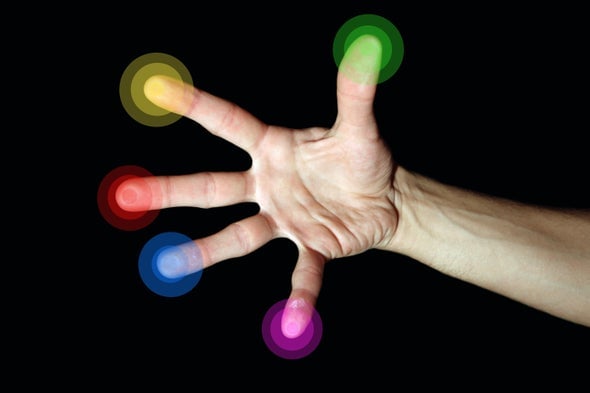 Adding a sense of touch can make virtual reality experiences feel more real. Credit: Richard Newstead Getty Images
Adding a sense of touch can make virtual reality experiences feel more real. Credit: Richard Newstead Getty Images
Imagine for a second that you are on a video call with someone close to you, be it a friend, relative, or significant other, and that in this scenario you are hundreds of miles apart. For all of the leaps and bounds made in recent years in being able to be in instant communication with any person across the globe in a moment’s notice, all with the pressing of a button to make people feel closer together, there is still no replacement for in person interaction. Inherently, we as humans love and rely on the aspects associated with in person interactions, one of the biggest being that of touch, the ability to feel the other person that simply can’t be replaced or simulated in any other way. Now imagine that on this hypothetical video call you could touch an interface on a separate screen, where a wireless patch on the back of the person on the other end would then vibrate in a pattern similar to your own enabling the other party to “feel” your unique physical touch. This is where a new patch conceived as a haptic device comes into play, a piece of technology that virtually sends off tactile signals.
Now, you might be wondering to yourself how this could work, and if such an idea is even fathomable to replicate such a feeling. In order to best illustrate such technology, a prime example in this scenario is the vibrating feeling in video game controllers matching with the action going on in the respective game. For example, when playing the EA Sports game Madden, in some versions of the game when you attempt to take a pressure field goal in the fourth quarter to beat your opponent, the controller will begin to vibrate in an effort to simulate the typical adverse circumstances that a kicker would undergo in reality, making it more of a challenge to make the kick than a typical field goal. According to John A. Rogers, a physical chemist and material scientist at Northwestern University whose team helped develop this haptic patch, “If you take a look at what exists today in VR and AR, it consists primarily of auditory and visual channels as the main basis for the sensory experience,” where he then goes on to say “But we think that the skin itself—the sense of touch—could qualitatively add to your experience that you could achieve with VR, beyond anything that’s possible with audio and video.”
While many have made efforts to develop these kinds of haptic devices, often times resulting in a vest or gloves paired with vibrating motors, many of the past attempts at creating something of this nature have required heavy battery packs connected by heaps of wires, making the experience far from its optimal end goal. As a result of this, Rogers and his team set out to develop a vibrating disk, that despite being only being a few millimeters thick can still run on very little energy. In fact, these actuators (a phrase used for devices that provide a system physical motion) require such little energy that they can actually be powered by near-field communication, a wireless process of transferring small amounts of power that is typically associated with applications such as unlocking a door with an ID card.
As stated by Jürgen Steimle, a computer scientist at Saarland University in Germany (who is not involved with the project team) “The power required for mechanical actuators has oftentimes been a limiting factor to making really massive and scalable use of these technologies in mobile applications.” Furthermore, the researchers “state that the individual actuators require less than two milliwatts of power, which is more than an order of magnitude less than what is typically used in prior work…. And this is a step change in my opinion, because it allows us to create new types of mobile devices that could be both effectively driven with a battery or they could even, like in this case, use wireless powering.”
In note of this, the correlating product looks like a lightweight soft patch of fabric-like material that can maneuver itself like a wet suit, maintaining direct contact with the individual’ skin as they move, with this material consisting of thin layers of electronics placed between protective silicone sheets. Through this, one layer possesses the near-field communication technology that drives the device, activating another layer filled with an arsenal of actuators, all of which can be activated individually and then tuned to different frequencies of vibration to convey either a stronger or weaker sensation. Slightly thinner than a mouse pad, this sandwich of electronics results in a rather tacky surface that can stick on the skin.
While Rogers acknowledges that this type of technology is already used in other devices, he believes that this particular patch combines all of the separate existing uses, elaborating that ““The miniaturized actuators; the wireless control strategies; the thin, flexible, soft construction; the soft, gentle interface with the skin; the battery-free operation—this is a collection of technology features that we don’t think have been reported in the past,” where he continues in stating ““When you put them all together, you end up with a completely different type of platform that I think will serve as a really powerful starting point for what could ultimately be a full-body suit where you have maybe 1,000 actuators and they’re all controlled simultaneously, with a form factor that people are actually going to want to use.”
As of now, the researchers have tested numerous prototype patches of many different forms to fit on various body parts, for example a circular patch for the back of the hand as opposed to an X-shaped one placed on the upper back. One particular trial included a family using the patch to touch remotely over video call. Going back to the video game example earlier as well, one test subject even wore multiple patches while playing a combat video game, where virtual strikes to his avatar’s body could be felt on the corresponding parts of his actual body.
Even in light of Rogers and his team having founded their own start-up business with the hopes of one day commercializing their device to the public, he says their main focus as it stands currently is to make the haptic patches thinner, lighter, with more range for flexibility. Furthermore, Rogers and his team also continue to experiment with the products sensitivity, as the actuators can be tuned to where they can vary the vibration frequencies depending on the part of the body, potentially even being able to display different kinds of touch from stronger to weaker sensations. The team isn’t stopping there either, as Rogers believes that one day future models could provide even more sensations, perhaps even being able to implement things such as temperature change or a twisting motion of the body.
The endless options and possibilities that could come as a result of these patches and its corresponding technology could be forever groundbreaking, with the ability to further advance society and our understanding of the interfaces associated with bringing virtual reality to life. With this device potentially integrating itself into society in the coming years, the meaning of virtual reality is still being evolved and pushed to the brink day in and day out, making this patch something people across the globe could use to revolutionize the way we view the tactile and haptic channel.
Why We Are One
For over 40 years, IBS Electronics Group has provided a broad range of integrated supply chain and electronicsmanufacturing solutions tailored specific to our customer's operations. As your one source for the industry’s top brands all in one place, our engineers specialize in reducing supply chain complexity and are here to provide you with dedicated support from prototype to production.




.png)


.png?resizemode=force&maxsidesize=96)